Loading...
- Bseiso Family Archive
- Archives
- Affiliates
- Stories
- News
- About
Loading...
Mahrous Bseiso Biography
/People
Updated October 18, 2024
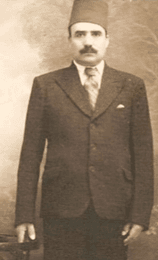
Mr. Mahrous was born to an affluent family in Jerusalem towards the end of the 19th century and the Ottoman rule to the region. His father, Mustafa Afandi, was a prominent pan-Palestine businessperson. The Bseiso family, to which Mahrous belongs, are a renowned elite family across the Levant and is a branch of the illustrious Kayali family. Mr. Mahrous had, therefore, multiple familial connections and exposure to business ventures in major Palestinian cities including Jaffa, Jerusalem, and Gaza.
Upon graduating school in Jerusalem, Mahrous started off his first successful business ventures in Jerusalem. He married and started a family of four in Jerusalem. However, the astute businessman sought opportunities in the virgin lands of south Palestine and began scoping the towns and areas to the south of Jerusalem. He finally decided on Bi’r Al-Sab’ with the vision of bringing this underexplored town to the ranks of such cities, like Jerusalem and Jaffa.
The Ottoman land deed is the oldest surviving document from the Bseiso family collection. The date of this document reflects how successful his business was in Jerusalem and could signal the first steps towards bringing Bi’r Al-Sab’ into the currently known agricultural oasis.
In the early 1900’s, Mr. Mahrous relocated to Bi’r Al-Sab’ which, then, was the center of the Ottoman district of the same name. Mahrous was not alone there, for his uncle Sha’aban and some of his immediate family members started business opportunities there. Beginning anew in Bi’r Al-Sab’, Mahrous remarried to Hajjah Jawaher Numan-Bseiso. They had eight children, one of whom was Jawdat who would accompany his father throughout the years.
The documents indicate that Mr. Mahrous bought a large piece of land, measured in the hundreds of dunams, in 1906 (0045). The Ottoman land deed is the oldest surviving document from the Bseiso family collection. The date of this document reflects how successful his business was in Jerusalem and could signal the first steps towards bringing Bi’r Al-Sab’ into the currently known agricultural oasis. Throughout the 1910’s, Mahrous continued to acquire land and establish farms and plantations. He oversaw such agricultural endeavors in person and made subcontracts to established farmers in the area to oversee their production. Documents 0027 and 0041 exemplify such subcontracts which involved the general public in his successes. His vision was to transform the modest desert outpost that is Bi’r Al-Sab’ into an industrial, agricultural, and democratic hub in the south of Palestine.
Starting from the mid 1920’s, Mr. Mahrous’ business ventures were booming in Bi’r Al-Sab’. The documents show massive land acquisitions (e.g., 0025, 0030, 0012, 0035). One of the major land purchases was finalized in 1929 when Mr. Mahrous purchased over 4631 dunams, a massive land area that measures around 1235 acres (see 0009). Moreover, Mr. Mahrous acquired most of the property of Mr. Hirzallah, another leading businessman in Bi’r Al-Sab’, in the 1930’s (see 0037, 0043, 0053, among others).
These lands were immediately converted into farms and mining operations. All of these land acquisitions were witnessed by the heads of tribes and pillars of the Bi’r Al-Sab’ society. Such surroundings surely indicate the increasingly advancing position of the burgeoning entrepreneur in the socio-economic ladder of the town.
During these great successes, Mr. Mahrous maintained his philanthropist efforts that he cultivated in Bi’r Al-Sab’ and in 1929 he commissioned the construction of a drinking water in the center of Bi’r Al-Sab’ (see 0046). The well that he financed was a major landmark in Bi’r Al-Sab’ and was repeatedly mentioned in books documenting Bi’r Al-Sab’ in that time period (e.g., the excerpt in document 0016). The Bseiso family, at large, were known for their humanitarianism. For example, one of the two mosques in Bi’r Al-Sab’ was financed by Mahrous’ brother, Eissa Bseiso. The family name itself comes from their grandfather’s benevolence to stray cats which he adopted in his wheat mills.
In addition to that, the documents further indicate that in achieving this success, Mahrous possessed admirable legal knowledge. The language and structure of the contracts that Mahrous wrote himself reflect his commendable prior education and knowledge that he, in his trailblazing efforts, applied in transforming a once-marginalized town to a thriving agricultural and economical hub in the south of Palestine.
Palestine in the first half of the twentieth century was the center of turmoil that culminated in the 1948 war. Mr. Mahrous’ legacy documents reflect the changing political powers there. One document in particular, 0005, shows that the sale transaction was conducted in various currencies that were in circulation in Palestine: a living manifestation of the ever-changing hands over Palestine.
Nonetheless, Mahrous was at the forefront of the economic development in Palestine at the time. Documents 0052, 0055, 0018 and 0051, for example, give a glimpse of the state-of-the-art cutting-edge agricultural machinery he introduced to Bi’r Al-Sab’. Contracts and leases from The Jaffa Iron Works and the Engineering Corporation of Palestine give clues to his vision of bringing progress to Bi’r Al-Sab’ despite the political ever-increasing unrest that was brewing.
In reality, by the end of the 1940’s Mr. Mahrous was the main economic player in Bi’r Al-Sab’ . Documents 0013, 0031, 0004, 0019 show the large amount of property for which his business acquisitions paid taxes. However, his successes in Bi’r Al-Sab’ were cut short by the 1948 war. Few documents narrate his business ventures afterwards, including 0032 which documents his founding of a company in the West Bank.
After the fall of Bi’r Al-Sab’ in 1948, Mr. Mahrous refused to give up his land and his successes. But he was forcibly removed from Bi’r Al-Sab’ to join the Palestinian diaspora.
After the fall of Bi’r Al-Sab’ in 1948, Mr. Mahrous refused to give up his land and his successes. But he was forcibly removed from Bi’r Al-Sab’ to join the Palestinian diaspora. Mr. Mahrous couldn’t carry much while under the crosshairs of weapons. The few surviving documents before you show only a handful of his property in Bi’r Al-Sab’ that, if mapped, could mean he owned much of the city as it stands today. Bi’r Al-Sab’ was renamed to its current colonial name of Beersheba at this time.
After 1948, Mr. Mahrous’ health deteriorated. He was aided by his much-beloved son Jawdat Mahrous Bseiso(the father of Adel) who assumed the perilous responsibility of managing what had become the shattered fragments of Marhrous’ lifelong accomplishments. Jawdat was only 24 years old when he and his family became refugees in their own country, but Mahrous saw in him the rising star to resurrect his dreams that the war has decimated. Jawdat lived up to his father’s expectations and he persevered to carry on the legacy and altruism of his father despite the catastrophe.
Mr. Mahrous passed away shortly after the 1967 war. He was interred to his final resting place in Ramallah in 1968. Despite the pain and suffering, Jawdat, Mahrous’ trusted companion in his final days, stayed the course. Evident in document 0047, Jawdat was maintaining and paying fees for a waqf in Jerusalem (a waqf is a land given out to charity, the one in the document further had a drinking water well for the public). Nowadays, many of Mahrous’ descendants are well-known businesspeople, educators, musicians, politicians and philanthropists across the globe. As Mahrous bequeathed these documents to Jawdat, Jawdat endowed them to his son, Adel, who is now the trusted guardian of this invaluable archive.
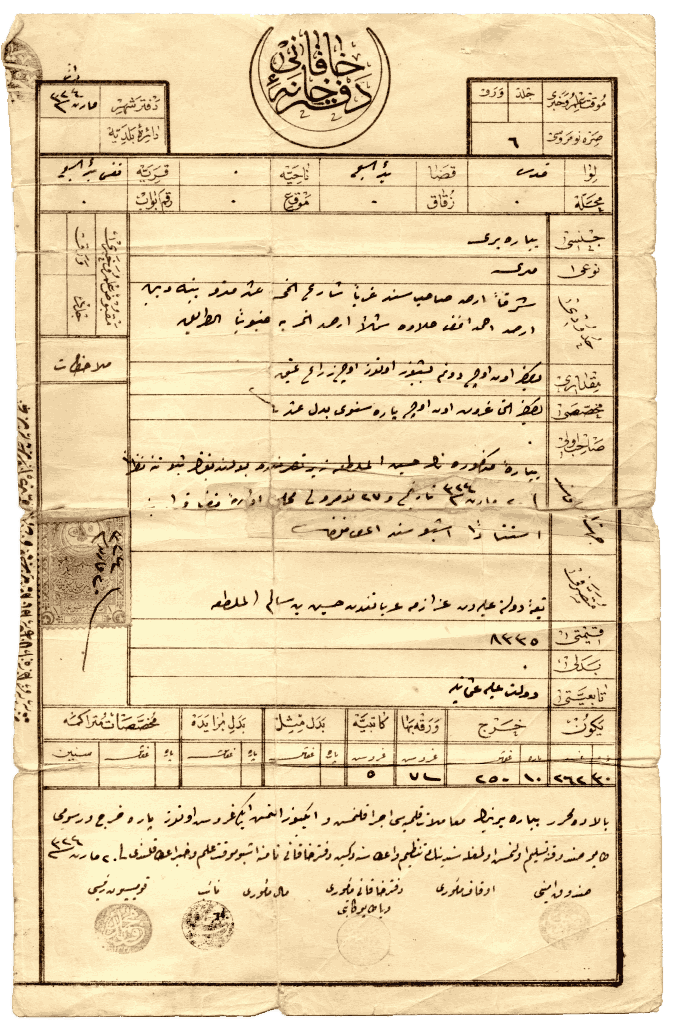
/ Land Deeds
This historical artifact is a rare and unique document within the family collection. This document is a Certificate of Registry for Land in Beersheba Palestine. However, unlike the other Land registered Deeds this document is written in Ottoman Turkish rather than Arabic. This certificate contains Ottoman Stamps and includes some writing in Arabic. The writings in Arabic were sufficient to extract that the land registered in land in Beersheba however the name of ownership is not stated in Arabic, but it is more than likely that this is land dating back to Ottoman times demonstrating ownership by the Bseiso family. This ancient artifact reflects a date stating, “2 March 1324.”
Read More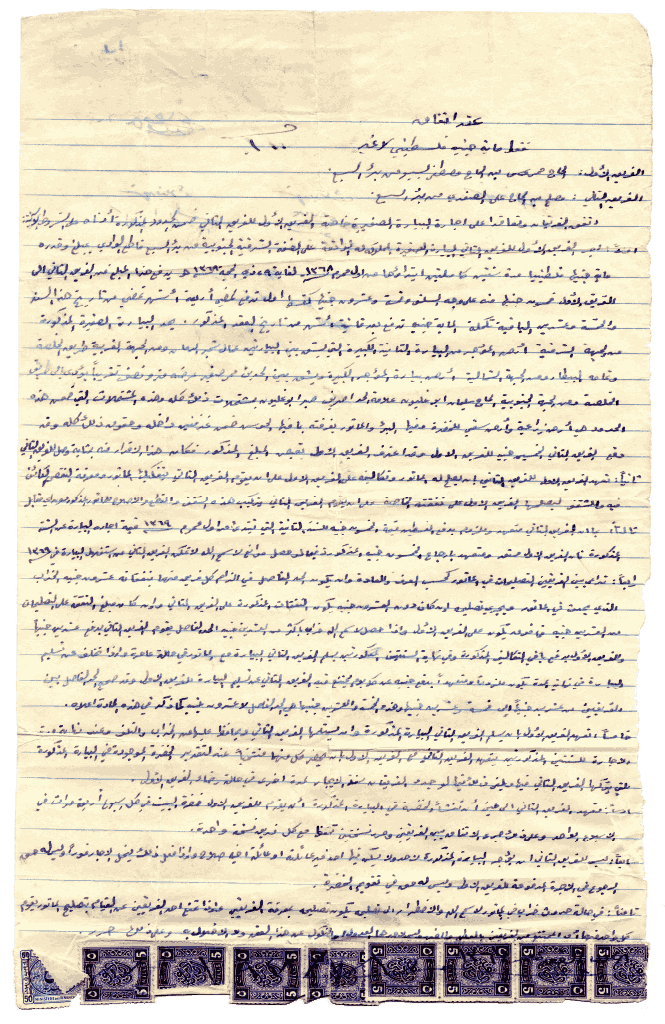
/ Contracts & Agreements
In October of 1948, Mr. Mahrous enters into a lease agreement with a customer to lease a Plantation for one hundred Palestinian pounds. The Lessee, who is renting the plantation, is Musleh bin Hajj Ali Al-Safadi from Beersheba. The Plantation is to be leased for 100 pounds and the first 50 pounds is due upon closing of the agreement, and the remaining 50 is to be paid in installments of 25 every four months. This plantation to be rented to the lessee is in Beersheba and its borders are described in depth within the lease agreement. This lease is also for usage rights for the small plantation which includes arable land and irrigated land for farming vegetables; a well with a mechanical water pump that installed in a room; and two rooms within the fence. This plantation demonstrates that Mahrous Bseiso was a land developer and industrialist of Southern Palestine. Mr. Bseiso owned expensive irrigation equipment and pumps used to water the lands for farming purposes, thus many lessees’ approached Mr. Bseiso in hopes of pursuing farming practices. The document also includes many legal provisions dividing liabilities for damages incurred onto the irrigation equipment and planation. This is an extensive and legally fortified lease agreement in which Mahrous spells out all cases of liability for damages incurred to his equipment for the duration of the lease. Moreover, this document is of high significance because the date of the document indicates that the lease agreement occurred after the Arab Israeli war which took place in May of 1948. The lease agreement was signed in October of 1948, and at this time the Israeli forces were in Palestine and declared an established state. This surfaces a question to curious readers, when did Beersheba become occupied and how did this impact the direct dealings between landowners and businesses.
Read More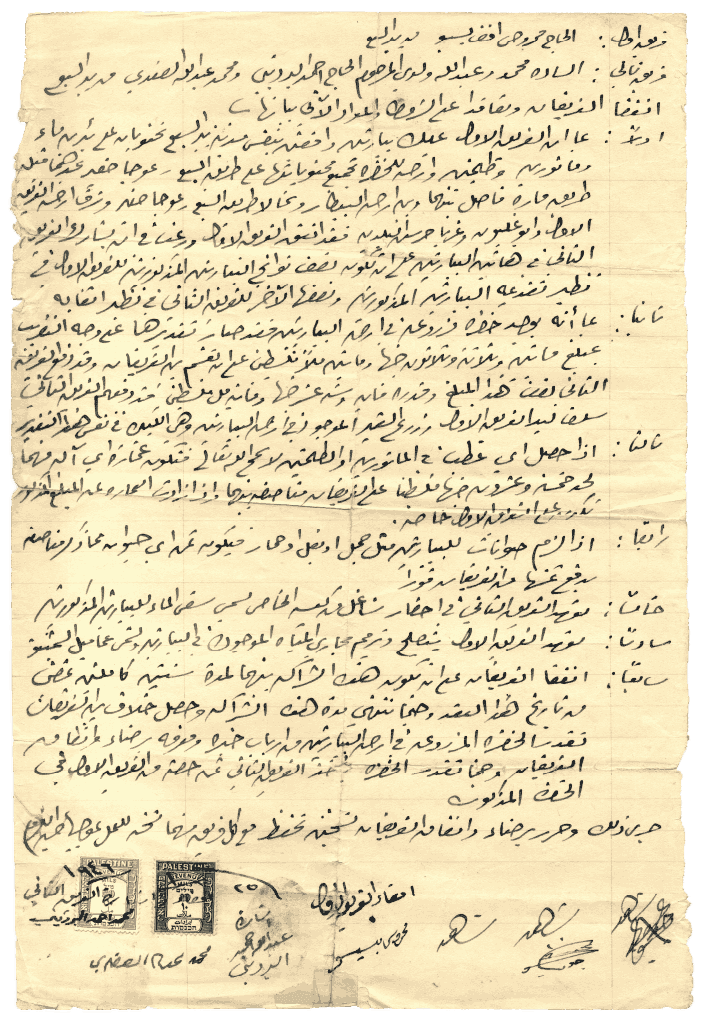
/ Contracts & Agreements
This agreement is a Reservoir Rental Contract between Mr. Mahrous Bseiso and a party of Users involving several families which include the Abdulla family, Bardini family and the Safadi family. The content of the agreement indicates that Mr. Mahrous Bseiso is renting out to the three parties two water reservoirs for the purposes of watering their respective farmland. In addition, the contract includes the material and machinery used to pump the water from the water reservoirs onto their crops in the fields. Mr. Mahrous agrees that renting parties will contribute to half of the value of the reservoirs, which is approximately 116 Mala (Palestinian currency). The agreement includes provisions that allocate liabilities of losses, damages, and repairs. This agreement was signed by both parties on January 25, 1946.
Read More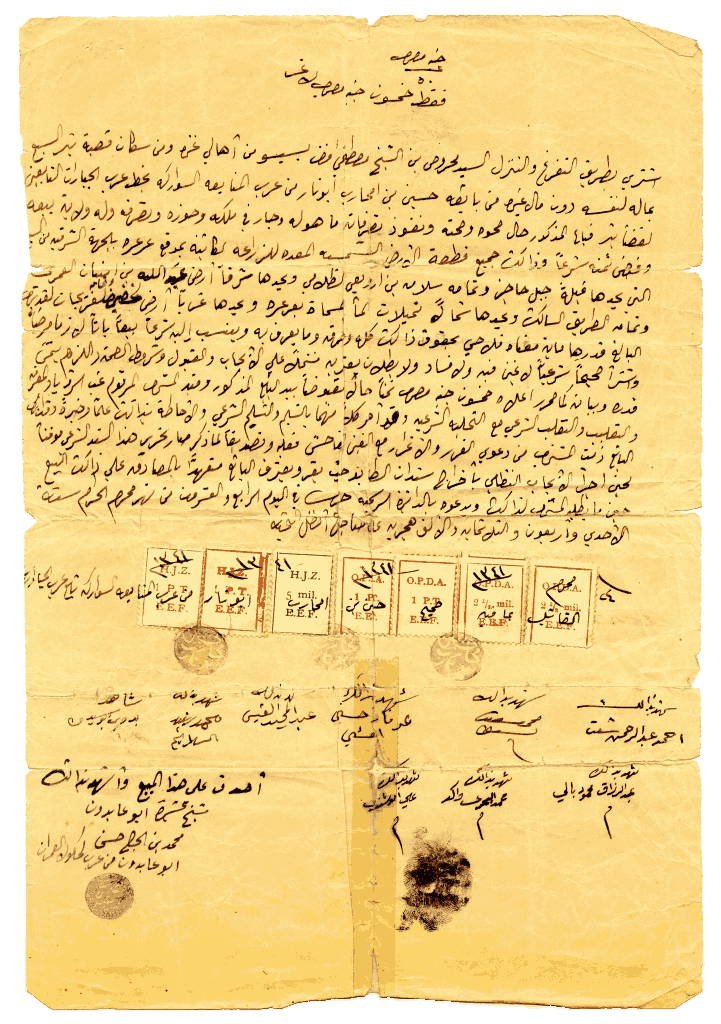
/ Land Deeds
This Land Sale Contract takes place in the 24th of Muharram of 1341 Hijri (Lunar Year). The respective buyer, Mr. Mahrous Bseiso, purchases land from the Seller, Hussain bin Muharib Abu Nar, which he sells property of arable land that is located in Ar'arat to the east of Beersheba and which has the following borders: to the south lies Mount Hajez and the remainder of the land of Salameh bin Rwai’ay Al-Thullamy; to the east lies the land of Abduallah bin Bunayyan Al-Omari and the remainder of the road; to the north lies Numailat Al-Ma’ which is also known as Ar’Arat; and to the west the land is bordered by the land of Al-Furaijat Al-Qudairi. The purchased land has an area of One Hundred Fellahin Muqtha’ah. In exchange for the land Mr. Bseiso is to forward the 50 Palestinian Pounds directly to the seller. In this contract the seller is verifying that he intends to formalize this written contract in the appropriate government bodies, Beersheba Land Registry, to transfer title to land to Mr. Bseiso. Although the document does not state the transaction in Gregorian years, the year 1922 is apparent in the signature area of the witness. Many documents are either in lunar or Gregorian dates, demonstrating the diverse systems in the societies of Palestine.
Read More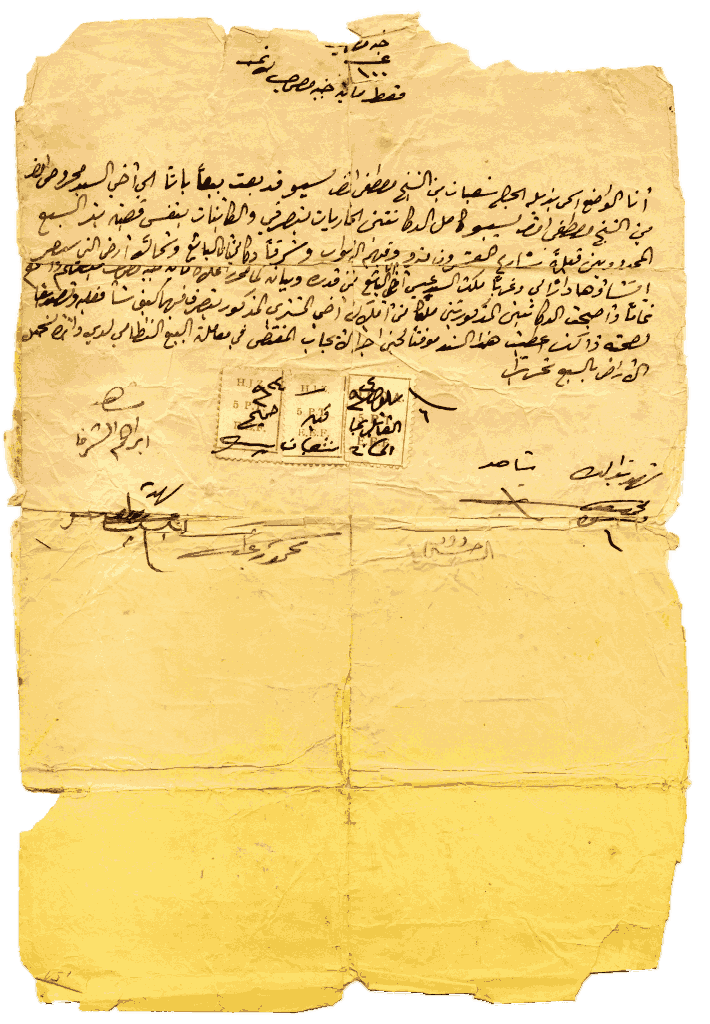
/ Contracts & Agreements
Unlike many contracts in the Bseiso collection this is a Sale Agreement in which Mr. Mahrous Bseiso is selling two shops to a buyer. However, the buyer is not just any ordinary neighbor or business acquittance but his own brother, Haj Sha’ban bin Sheikh Mustafa Afandi Bseiso. The sale is for the entirety of two shops owned by Mr. Mahrous which are in the center ‘Qasbah’ of Beersheba. This agreement takes place in September of 1924 for the total amount of 100 Egyptian Pounds. Mahrous Bseiso agrees to finalize this agreement by attending the Land Registry and providing final title to his brother in a specified time. This interesting agreement demonstrates that Mr. Bseiso, as like many other agreements, is heavily involved in family businesses. Many land Sale Contracts in the Bseiso collection are often witnessed and signed by his family members, including the buyer, Haj Sha’ban. The Bseiso family appears to have a deep involvement in land development and real estate in the District of Beersheba.
Read More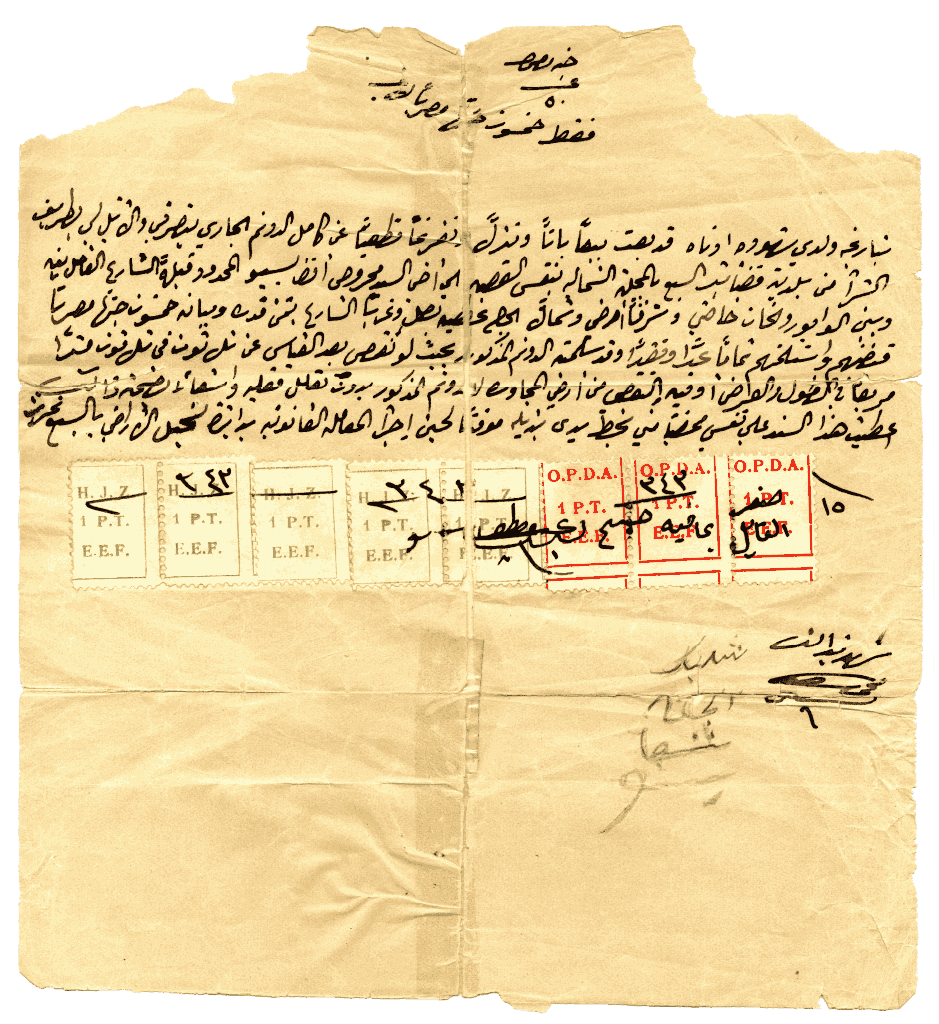
/ Contracts & Agreements
On Safar 15th, 1343, of the Hijri Calendar, which would have been September 14th, 1924, Mr. Bseiso entered into another agreement to acquire land. A full dunam of land was transferred by the true owner to Mr. Bseiso for Fifty Egyptian Pounds by way of purchase from the Municipality of the district of Beersheba. The perimeter of land was defined in the agreement and validity was ensured; the agreement was certified as ownership transfer to Mr. Bseiso and 8 different Revenue stamps appear at the bottom of the document. Moreover, there are signatures by two witnesses to the aforementioned agreement.
Read More
/ Land Deeds
This document is a certificate of registration to Mr. Mahrous from the Government of Palestine Land Registry Office of Beersheba District (Kaza) with a petition number of 6/26 and deed number 42/26. The certificate contains the land classification, description of the property, boundaries, the area of land, the shares, the nature of the transaction, and consideration of price. This certificate not only shows Mr. Mahrous was the owner of the land described therein, but it also demonstrates the historical significance of the Palestinian State institutions and property mechanisms that were in place by municipalities to determine and register land ownership at the time. Mr. Mahrous went through the proper channels and obtained the required certification in order to complete his vision of industrializing Beersheba. As we see at the bottom there are two authentication methods used: one being the Seal of Land Registry Office dated November 8th, 1926, and the second being the Signature of Registrar of Lands.
Read More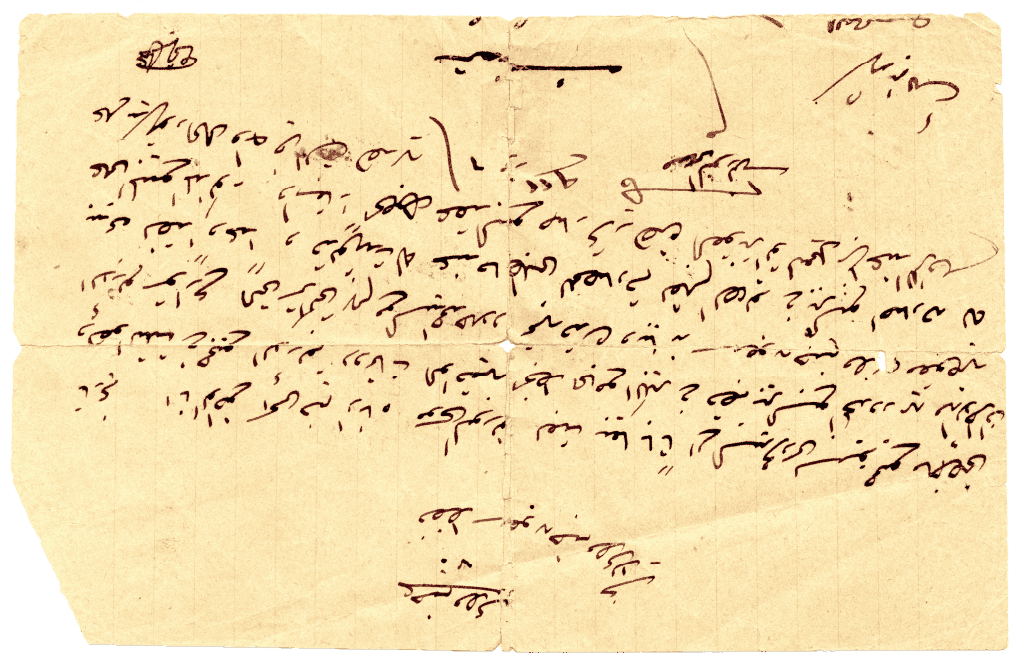
/ Contracts & Agreements
The is a Property Sale Agreement between the seller, Moussa Al Alburieni, and the purchaser, Mr. Mahrous Bseiso. This agreement was written at the time of the transaction which took place on June 6 of 1922. The seller, Mr. Alburieni, sells 1/3 of the total 4 dunams to Mr. Bseiso. The land in question is referred to being near the Great Mosque in Beersheba Palestine. The witnesses to this agreement are as follows: Faisar Al Thawrana, Sahid Al Masma, and a third witness whose signature is not readable. On July 6 1922, Mr. Mahrous Bseiso took another step in fulfilling his vision of industrializing Beersheba with another real estate purchase. Mr. Bseiso acquired four dunams of land located parallel to the Great Mosque in the center of Beersheba for a total price of seventy Egyptian Pounds. This land sale contract was witnessed and signed by four people to comply with legal formalities and to certify the sale at the land registry department in Beersheba.
Read More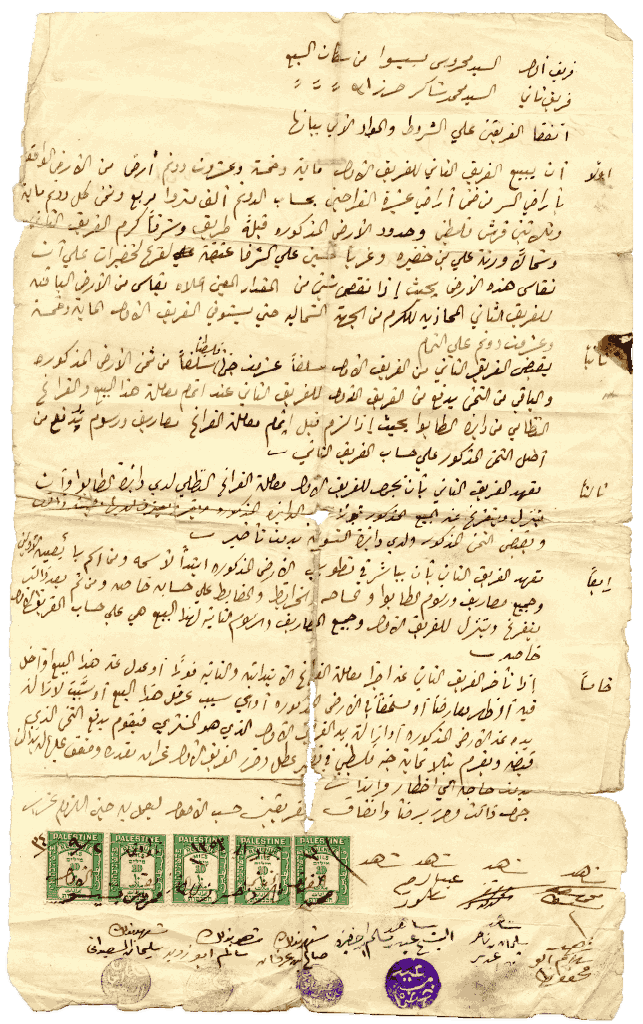
/ Land Deeds
This document is a land sale contract entered into on or about September 2nd, 1934, between Mr. Mahrous Bseiso and Mohammad Shaker Hirzallah both residents of Beersheba, Palestine. Per this contract, Mohammad Shaker Hirzallah was to sell Mahrous Bseiso one hundred and twenty-five dunams of land (described as one hundred twenty-five thousand square meters) from the lands of the Al-Sir area within the lands of the tribes of Al-Farrahayn for 16,250 Palestinian qirsh. This contract not only suggests Mahrous’ Bseiso’s ownership of the land described but the contract also makes reference to the existing Land Registry Office and lists the names of other Palestinian landowners in 1934, approximately 14 years prior to the Arab-Israeli War in 1948. This document was witnessed by Salameh Abu Mahfouz, Salman Bin Naser Bin Ghadeer, Sheikh Eid Musallam Bin Khudayrah, Salih bin Erfan, Salem Abu Zuwayyed, Suleiman Al-Su’aydani.
Read More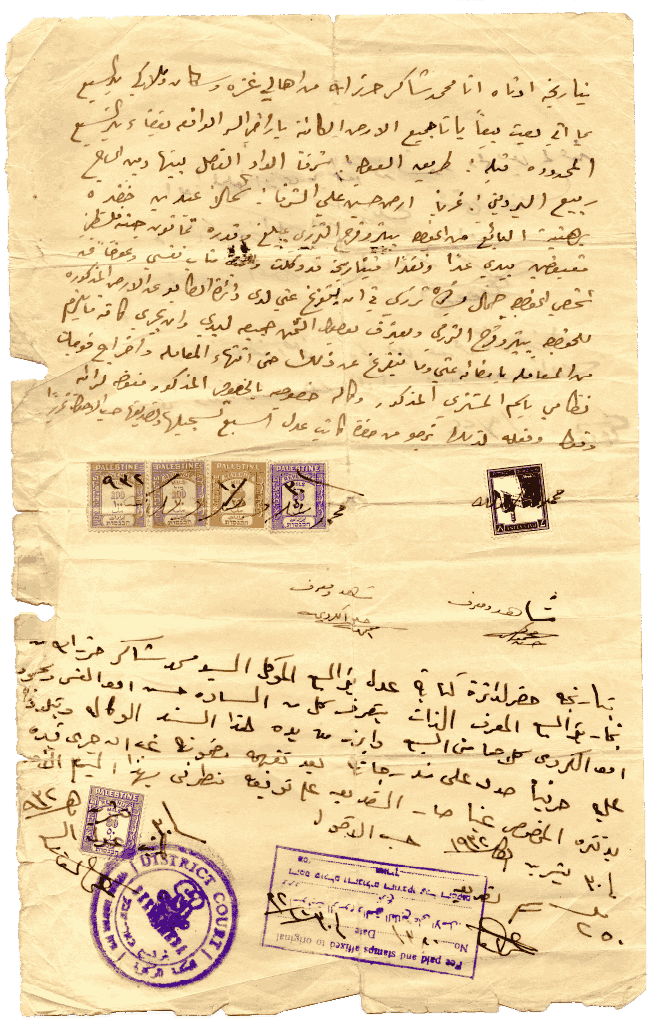
/ Land Deeds
This 90-year-old document was created on October 30th, 1932, and reflects a land sale agreement between the seller, Mohamed Shakir Herzallah of Gaza, and the buyer, Mr. Mahrous Bseiso of Beersheba. In this agreement the seller, Mr. Herzallah, is agreeing to sell land in the Sir area. The written contract does not state the measurement if land to be sold but instead the seller states that he will sell his land as a “whole.” This may infer that Mr. Herzallah is selling of his land in Al-Sir to Mr. Bseiso. The amount paid for the purchasing of the land is 80 Palestinian pounds. The second half of the document reflects the attendance of the seller’s legal representative to the Municipal Registry to negotiate on behalf of Mr. Shakir. In addition, this representative referred to as “wakeel” and has brought forward the proper documents to register the lands sold to Mr. Bseiso in his respective name.
Read More
/ Land Deeds
In 1931 while the last Palestinian census was carried out by the British Mandate, Mr. Mahrous was continuing to buy land in his quest to industrialize Beersheba. On November 9th, 1931, Mohammad Bin Shaker Hirzallah and Mr. Mahrous entered into a land sale agreement in which Hirzallah sold two thousand eight hundred and thirty-three legal Dunams to Mr. Mahrous for the sum of one hundred and sixty-two Palestinian pounds and five hundred mills. This agreement was witnessed by Salem Ali Hirzallah evidenced by the sign and seal and was also signed by Mr. Mahrous and Hirzallah.
Read More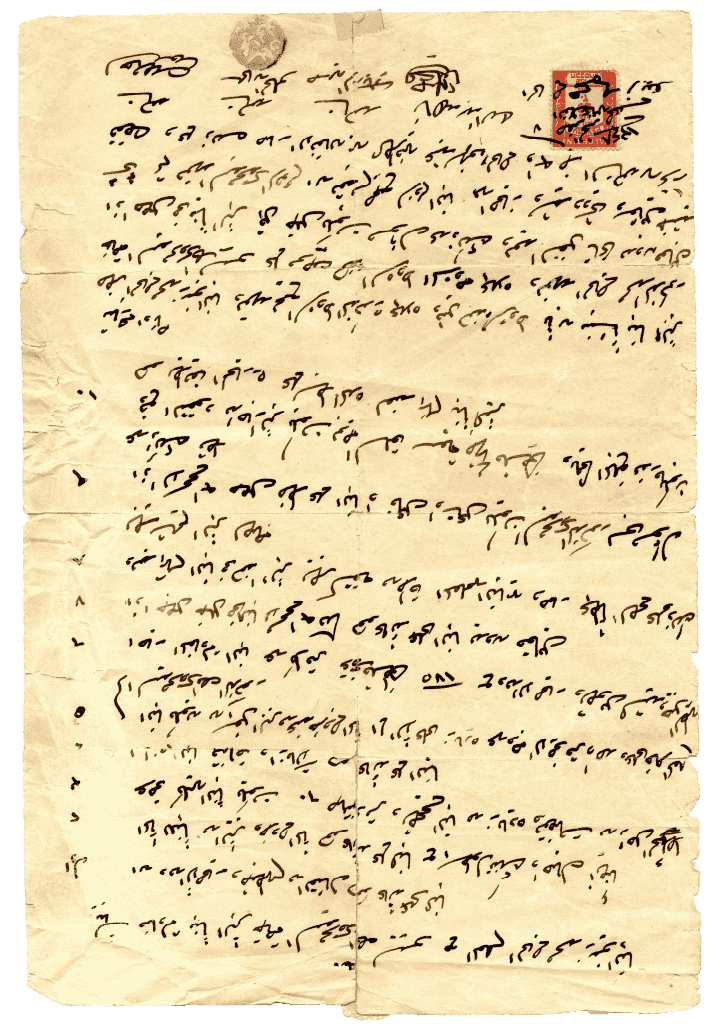
/ Contracts & Agreements
Mr. Mahrous was more than a land purchaser, he also helped build infrastructure in his endeavor to industrialize Beersheba. This document is a contracting agreement between Mahrous Bseiso and Haj Mohammed Zeino for the latter to construct Mr. Mahrous a well. The agreement lays out the work to be completed and contains parties, obligations, indemnities, and conditions for payment. The document has a Palestinian Revenue stamp and signatures of Mr. Zeino and Suleiman Helo who was a witness to the agreement.
Read More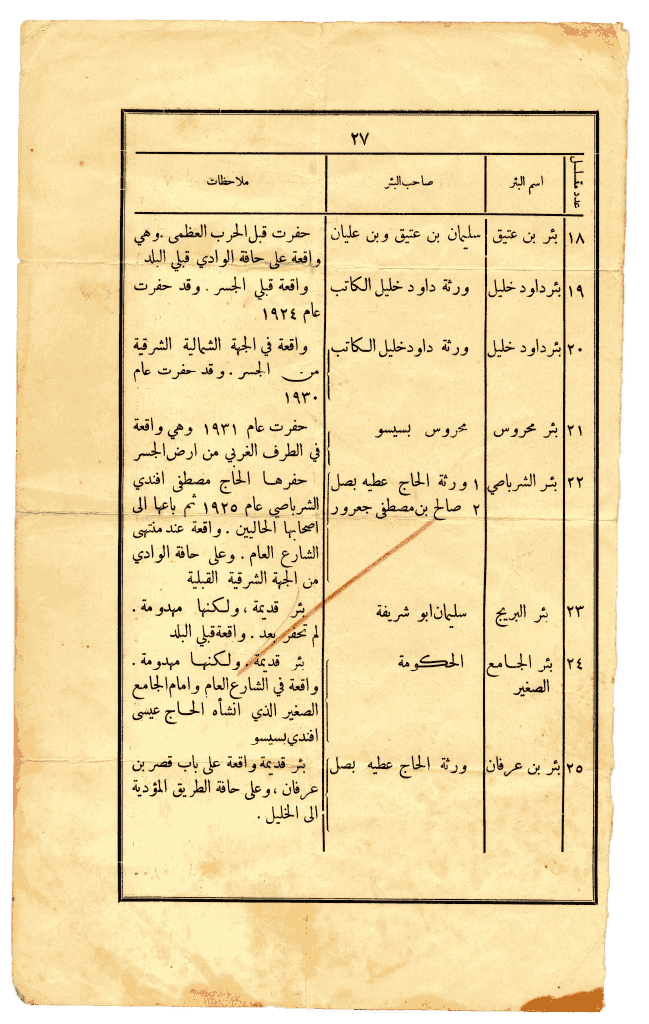
/ Land Deeds
This document evidences that Mahrous Bseiso owned a drinking-water well titled the “Mahrous Well” that was dug in 1931 and located on the western side of an unidentified bridge. Although the exact location of the well was not mentioned, because the document makes reference to the road to Hebron; when discussing another well, it can be inferred that Mahrous Bseiso’s well was located in or near the West Bank. This document not only evidence’s Mahrous’ Bseiso’s ownership of a drinking well in Palestine approximately 17 years prior to the Arab-Israeli War in 1948, but also evidences that there were several other documented Palestinian drinking-well owners during this time period as well, whose names have been listed alongside Bseiso’s.
Read More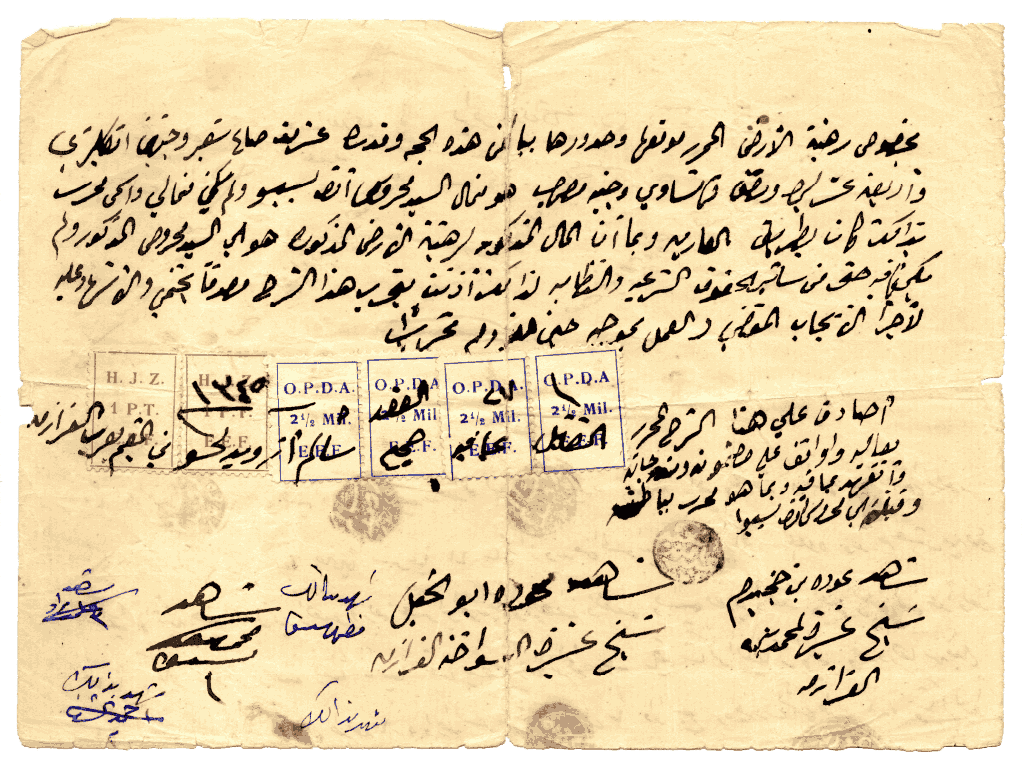
/ Contracts & Agreements
At a young age Mr. Mahrous Bseiso sought to develop the land and infrastructure of Beersheba by committing to purchases of undeveloped land. Mr. Mahrous not only developed his own land, but also sought the land of others, particularly residents who did not have the financial stability to afford maintenance of the land or its development. In May of 1927, Mr. Mahrous assisted other financially troubled landowners with liens on their lands, in exchange for monetary loans. In this document which dates to over 90 years old, Mr. Bseiso acquired equitable title to the land of the borrower in exchange for Twenty Sa (measured in 3.24 kg), two English pounds, 24.5 Francs, and one Egyptian pound. The agreement further explains that Mahrous has legal authority to cultivate and develop the land as he pleases in exchange for the money borrowed. This historical document is witnessed and signed by heads of families and stamped with Palestinian issued stamps of the government. This historical artifact is a testament to the ownership and legally sanctioned transactions of residents in Beersheba Palestine.
Read More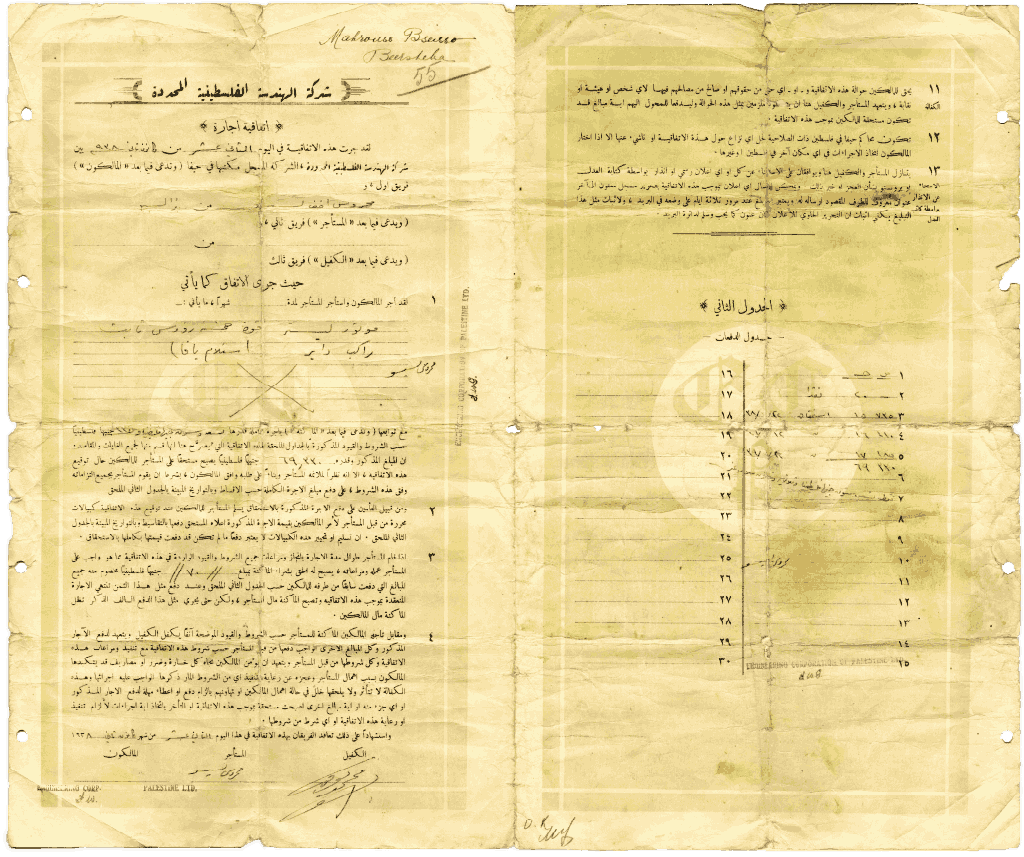
/ Other
The document is titled The Second Appendix and starts off by having conditions carry over from the last document and then showing a payments schedule. The schedule lists what currency will be used and when payments are due. Moreover, the schedule contains Mr. Mahrous’ name on box 10 indicating that Mr. Mahrous was part of the payment schedule. At the end of page one, we see an agreement between the Engineering Corporation of Palestine Ltd and Mr. Mahrous. The agreement was a leasing agreement for machines and contained the terms and conditions to follow as well as the parties. The agreement was signed before witnesses on January 12, 1938, and contains the signatures of the guarantor, the lessee, and the owners.
Read More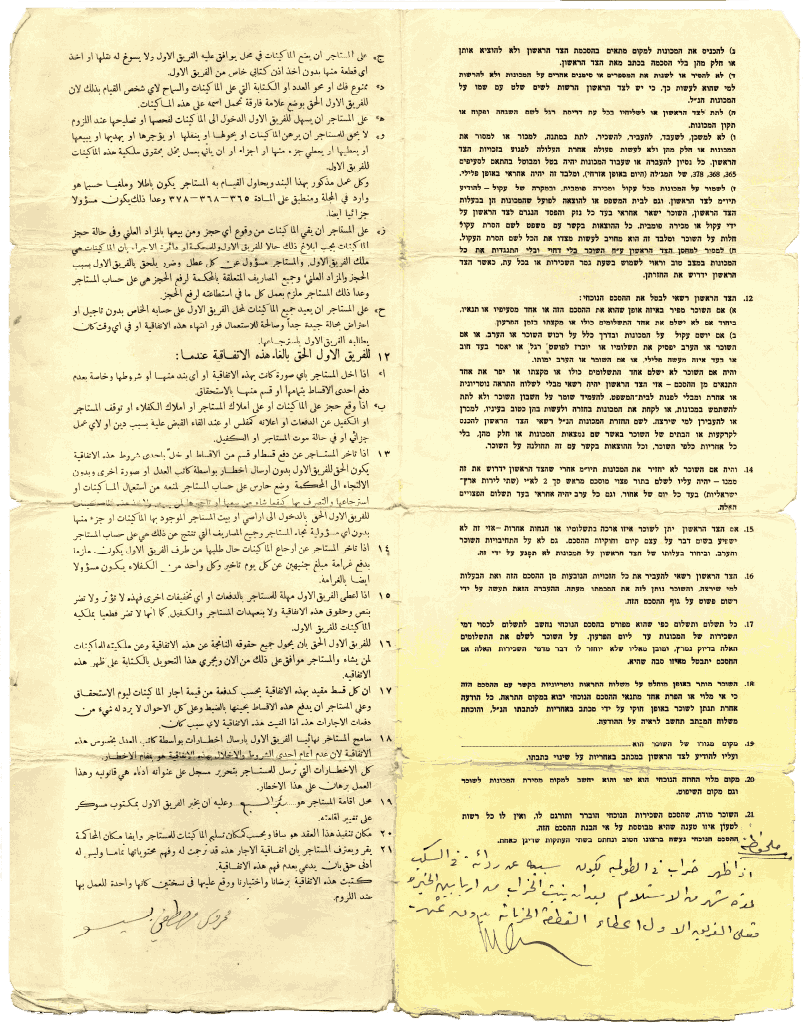
/ Other
In this document we see a table that is written in English on the left side and Hebrew on the right. The table seems to outline terms and conditions of a lease agreement indicating that the agreement was written in two copies and was consensually signed by the two parties. Furthermore, the agreement was in Mr. Mahrous’ handwriting. Once again, we see the detail and specificity in Mr. Mahrous’ dealings to make sure there were no vague or ambiguous clauses and to ensure the contract would be upheld if challenged.
Read More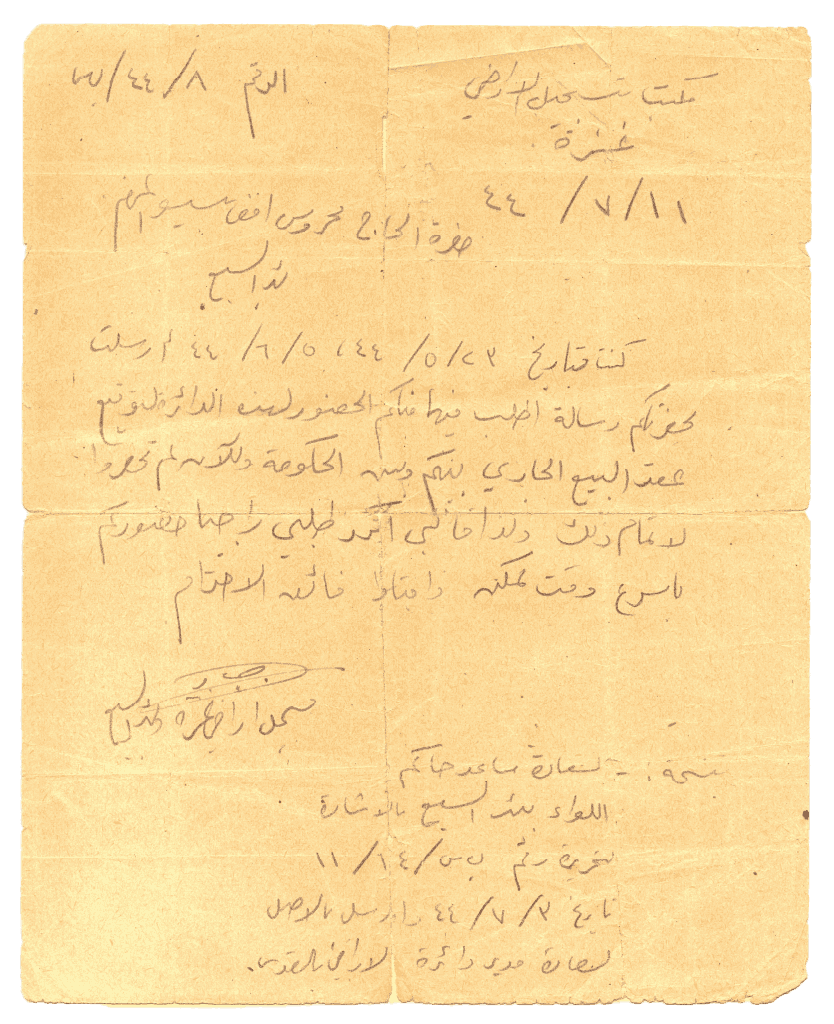
/ Other
In this letter dated July 11th, 1944, the Land Registry of Gaza and Beersheba wrote to Hajj Mahrous Afandi Bseiso requesting that Hajj Bseiso appear before the directorate to sign a contract for a transaction he had with the government. With this letter being from the Land Registry of Gaza and Beersheba, it can be inferred from this document that the contract between Hajj Bseiso and the government was for the purchase of real property located in Gaza or Beersheba by Hajj Bseiso. Hajj Bseiso acquired large amounts of undeveloped real property from the government with the plans to develop said lands. This document also evidences the existence of a Land Registry of Gaza and Beersheba which appears to have existed in Palestine at least four years prior to the Arab-Israeli War in 1948.
Read More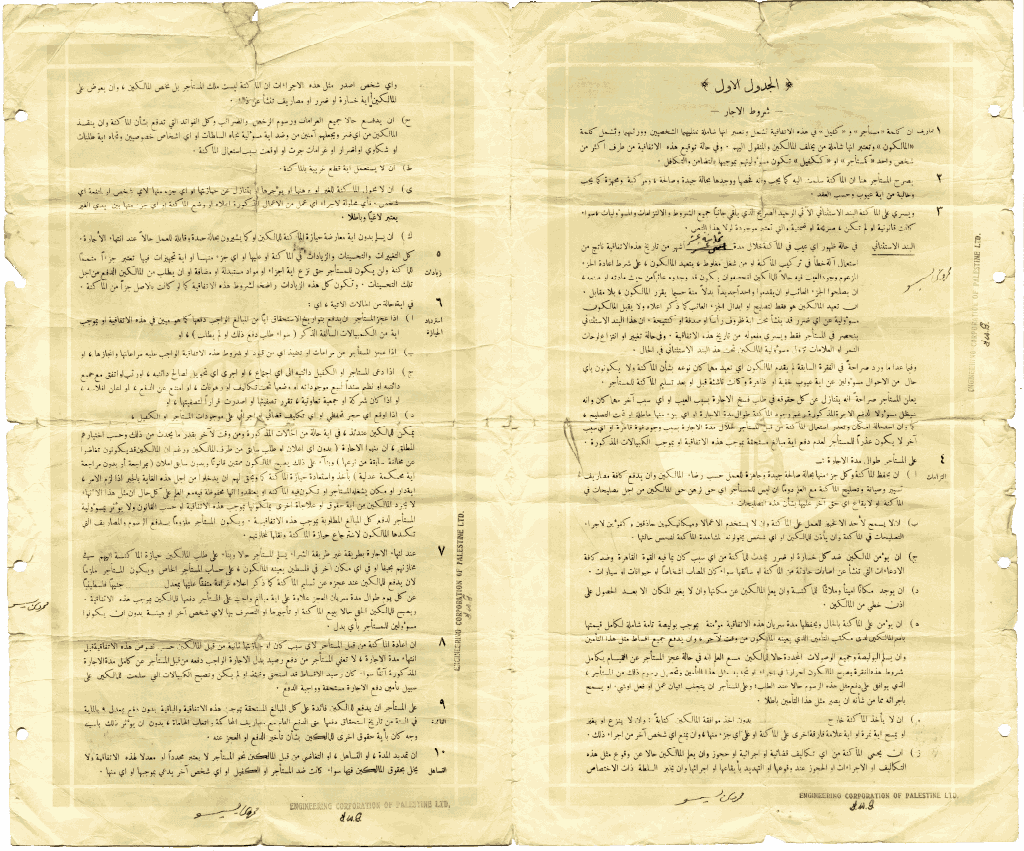
/ Contracts & Agreements
The document is titled The First Appendix and lists certain conditions and the results of such conditions. The lease terms are further detailed in this agreement and is also Mr. Mahrous’ handwriting. At the end of page one there is a stamp form the Engineering Corporation of Palestine Ltd followed by another similar stamp at the end of the document. The agreement shows the visionary Mr. Mahrous was because of the specificity and spelling out the terms as detailed as possible to make sure there could be no ambiguity.
Read More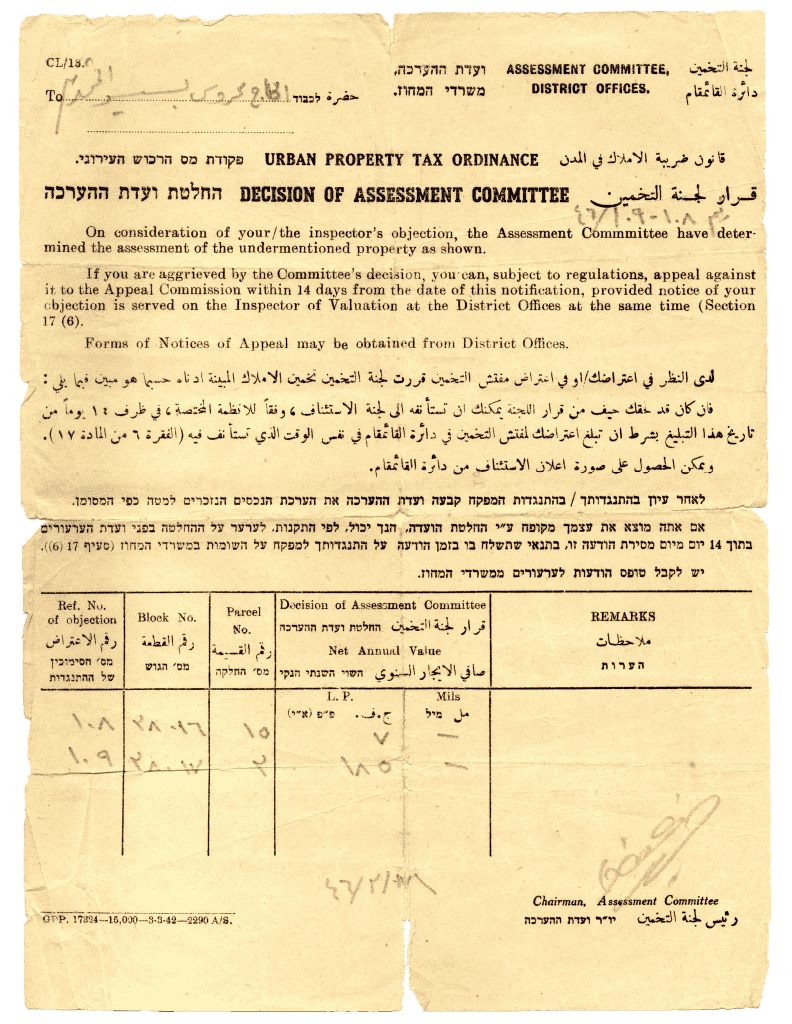
/ Tax Documents
This document is a letter from a Land Assessment Committee to Hajj Mahrous Bseiso. The letter makes reference to a particular parcel of land owned by Bseiso and an inspection that was done to said land by the Committee. Among other things, the letter describes the location of the land parcel and the net value of the land in LP or “Palestinian Pounds”. This letter is just one of many documents that prove Mr. Mahrous Bseiso was the documented owner of a large amount of land throughout Palestine. Mr. Mahrous Bseiso owned so much land in fact; he could rightfully be compared to a “John D. Rockefeller Jr.” when considering the vast amount of real estate ownership and development that took place in Palestine during Bseiso’s lifetime.
Read More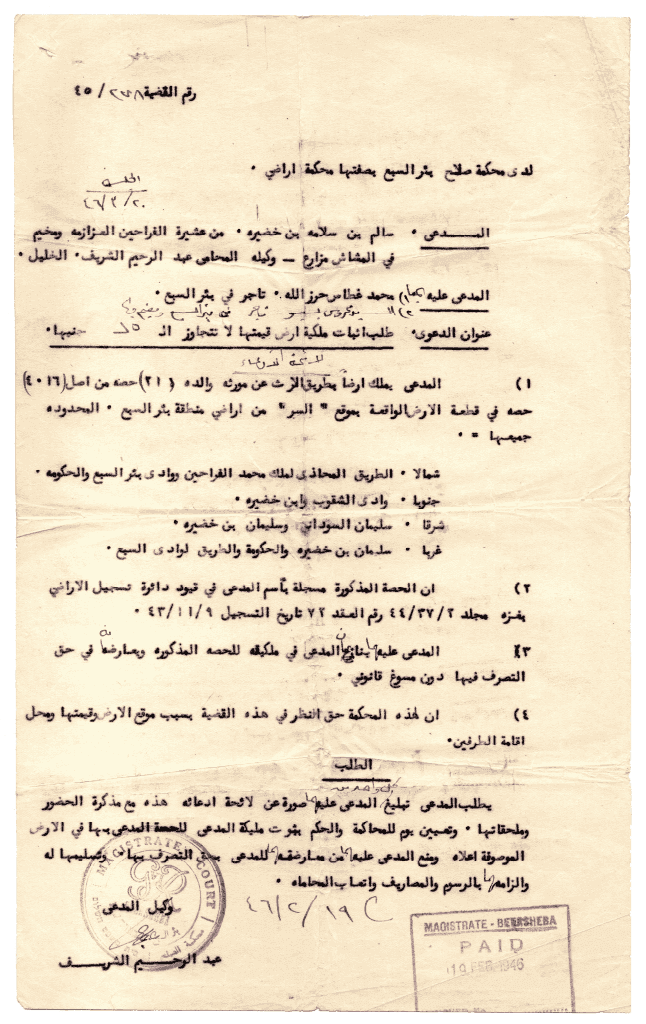
/ Other
On February 19th, 1946, Plaintiff Salem bin Salameh brought a dispute of land claim against Mr. Mahrous Bseiso challenging Mr. Bseiso’s right to ownership. This claim was brought at the Magistrates’ Court of Beersheba in its capacity as the Land Court. A case number of 278/45 was assigned, and the court determined that venue was proper, and the court had jurisdiction to hear the case. The official seal of the Magistrates’ Court of Beersheba can be seen at the bottom of this document reinforcing veracity and authenticity and a hearing date was set for March 20, 1946.
Read More
/ Tax Documents
Mr. Mahrous Bseiso’s vision to industrialize Beersheba is further shown by his allocation of houses and shops in Beersheba. On November 11, 1946, Mr. Mahrous Afandi Bseiso paid 2 pounds for current general taxes for the year 1946, 1 pound current lore tax for the year 1946, and 2 pounds 190 mils current property tax for the year 1946. This brought the total paid to 5 pounds and 190 mils for the aforementioned. This document was numbered 9825 and had a write-off book number of 675. It was signed by the recipient and issued by the Beersheba Municipality Directorate.
Read More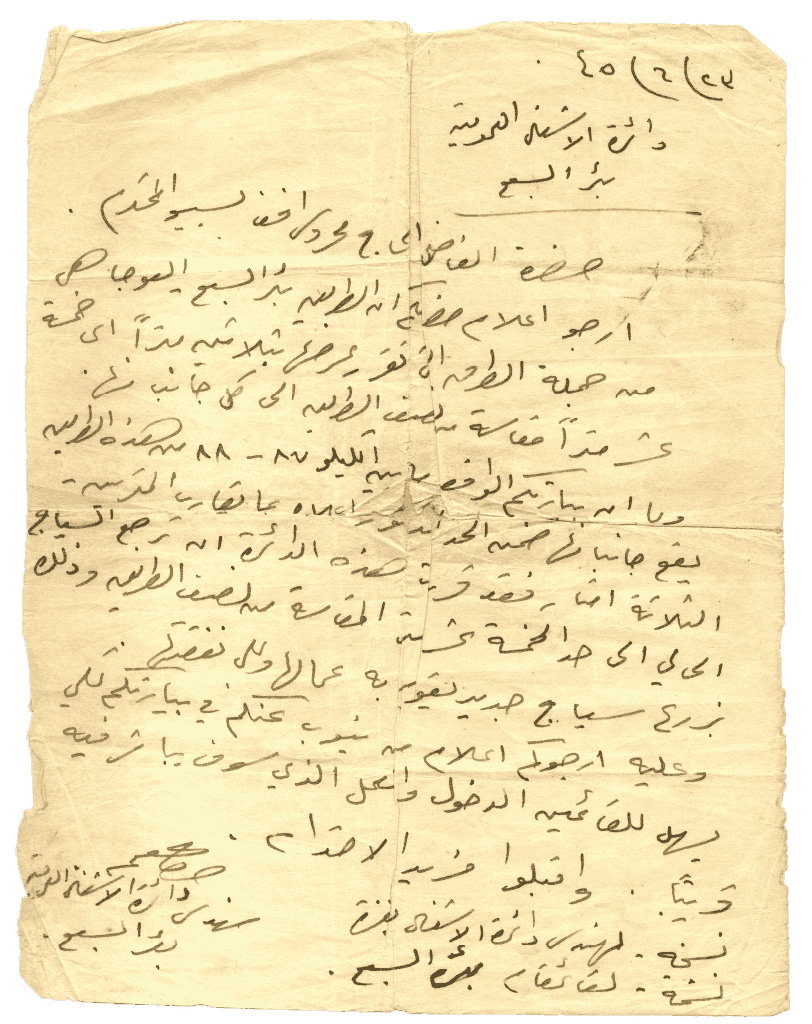
/ Tax Documents
In June of 1945, the Department of Public Works of Gaza sent a brief letter to Mr. Mahrous Bseiso informing him of upcoming construction plans which would require Mr. Bseiso’s consent and knowledge. This letter was sent by the head Engineer of the Department specifying that the government workers would enter Mr. Bseiso’s plantation and install a government fence to enhance border lines. The plantation is described as the area between Main government Roads referred to as “87” and “88.” The significance of this document establishes ownership of a plantation for Mr. Mahrous and establishes the existence of the Department of Public Works in Palestine prior to the Arab-Israeli War in 1948. This letter was also sent to the Lieutenant Governor of Beersheba Palestine for authentication purposes.
Read More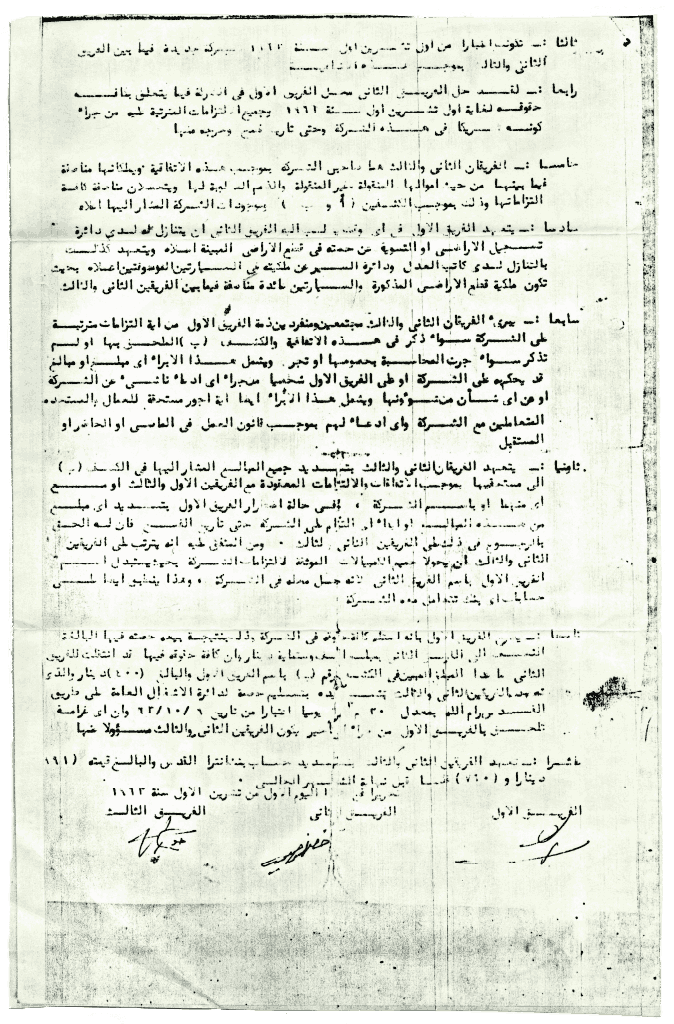
/ Contracts & Agreements
Mr. Mahrous was a visionary and as a part of his vision to industrialize Beersheba, Mr. Mahrous made sure all his dealings were recorded. In this document, we see a contract was entered into between three parties. A new company was formed on October 1st, 1963, between the second and third party. The contract outlined each of the party’s duties and responsibilities including asset and debt allocation. The different contractual clauses were very detailed and covered a range of legal implications from the share of ownership to any release of liability. The document ends with the signatures of all three parties.
Read More
/ Land Deeds
In this document we see a table describing parcels of land. From this table we can tell that there are three parcels of property. All three properties are in the district of Jerusalem and in a village by the name of Beit Hanina. The table further identifies the parcel name and number, the lot number, the owners and rights holders, the shares, land area, value, land type, and any remarks attributed to the property. The first lot contains remarks that the land includes a well and that the totality of the land is a waqf. The revenue of the waqf was to be dedicated in half to Hebron and the other half for charity work. It is evident that even in his venture to industrialize, Mr. Mahrous was a humanitarian and always thought about charity. The document contains land court stamps and Land Settlement Court signature.
Read More